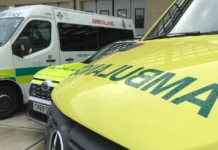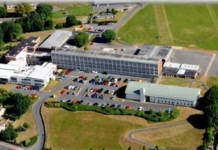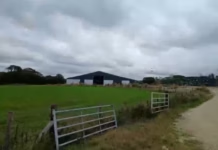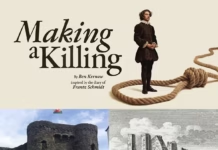By Jonathan Williams
It took sometime but we finally managed to get replies to nearly all of our questions. We asked the first question following our original article ‘Prince Philip Hospital to be downgraded’ which was back in the second week of August.
These original questions and the subsequent replies from the Health Board generated even more questions. If you read our previous article, ‘It’s official, Llanelli doesn’t have an A&E’ then will understand some of the confusion which exists concerning their plans.
It has been said by some people that the Board has already made its mind up, that the consultation process could be described as a ‘sham’ and that Prince Philip Hospital (PPH) is being scaled back and eventually closed.
We can’t honestly believe those rumours as there doesn’t appear to be any evidence to back it up and the Board have always stated that PPH is receiving more services and it is only a name change with regards to the A&E department.
However, what is clear is that the people of Llanelli do think that PPH has an A&E regardless of what the Board say and we have told them this. If we haven’t got or had an A&E, then where did it go and what happened?
We will eventually find out what hospital services we’ll have when the consultation process finishes and the plans are implemented. In the meantime, I leave you to read the questions and answers that we had back from the Board and make up you’re own mind. As always, please feel free to comment.
In Part 1, the questions deal with PPH A&E.
1) What changes will you be making to emergency services at Prince Philip Hospital?
Our proposals mean there will be very little difference in terms of the types of patients that will be seen in Prince Philip Hospital and in the treatment that they receive.
We want to improve your access to the care you need and so we are proposing to:
- Direct adult medical emergencies (e.g. strokes, diabetes, infections, asthma attacks, anaphylaxis, septicaemia, heart failure, COPD and many other medical conditions) straight to a consultant-led Emergency Medical Assessment Unit. This is an improvement for medically unwell patients as they will come directly into the hospital, bypassing the local accident centre and with only one assessment as opposed to two. You will therefore get much quicker access to a physician for the treatment you need.These patients currently account for around 20% of emergency patients treated at Prince Philip Hospital. The majority of emergency medical patients come into the hospital via the ambulance service or by referral from GPs and this would continue under the new proposal.
- Introduce a 24/7 nurse-led Local Accident Centre. We are committed to supporting highly trained emergency nurses to deliver the care and treatment for the majority of patients. Nurses will be supported 24/7 by A&E consultants through telemedicine, a common tool used everyday in Hywel Dda Health Board and across the NHS. This technology allows consultants to view X-rays and other results of patients from a different building and also allows consultants to speak directly to patients and nurse practitioners via a video link. This will improve services as currently, the hospital provides a consultant-led emergency service in-hours and a GP-led service out of hours.
- Nurses would be trained to make assessments and transfer if necessary.
2) Where will the unit be located?
The Medical Admissions Unit will be located at Prince Philip Hospital.
3) What is an Emergency Medical Assessment Unit?
This service enables the urgent assessment and treatment of medical emergencies and will be consultant led 24 hours per day, 7 days per week. Conditions treated include asthma, heart failure, stroke, collapse, pneumonia, diabetic emergencies, anaphylaxis, septicaemia, COPD and many other conditions.
4) What does consultant led mean, what will they do there exactly? Does that mean I would see a consultant firstly or would a nurse call the consultant if she couldn’t deal with me? I would be under the impression that I would be seen by a consultant. Is this true?
Hywel Dda Health Board wants to bring medical emergency patients (e.g. patients with strokes, diabetes, infections and asthma attacks) directly into the hospital through an Emergency Medical Admission Unit. This unit would be consultant led and available 24 hours, seven days a week. The plans would improve the assessment and management for the most unwell medical patients.
Dr Phil Kloer said: “This is an improvement for medically unwell patients as they will come directly into the hospital, bypassing the walk-in unit and with only one assessment as opposed to two. They will therefore get much quicker access to a physician for the treatment that they need.”
The majority of emergency medical patients come into the hospital via the ambulance service or by referral from GPs and this would continue under the new proposal.
Alongside this, the current A&E Department would be more appropriately called a Local Accident Centre. Skilled emergency nurse practitioners would provide care for all patients who currently attend with minor injuries and illnesses (cuts, sprains, very minor burns). This service would be provided 24 hours per day, seven days a week, and nurses would be trained to make assessments and transfer if necessary.
Consultant led means there is access to a consultant either within the department or on call, as is the currently the case.
5) At the moment though, I see a doctor when I go to PPH and I know of people who have had heart problems and have gone straight there. Would they see a doctor straight away or would they have to be assessed by a nurse and wait for the on call consultant?
Cardiology services will continue to be provided at Prince Philip Hospital. Our preferred proposal would reduce the number of assessments for most emergency patients. For example, the vast majority of emergency patients come into the hospital via blue lights or from GP referrals and we propose to allow them to refer directly into the consultant-led Emergency Medical Admissions Unit, avoiding the need to go through the Local Accident Centre. If a patient walks into the Local Accident Centre, the emergency nurses are trained to make assessments and transfer if needed.
The vast majority of patients who attend Prince Philip A&E currently have minor injuries or illnesses and are already treated appropriately by skilled emergency nurses and not doctors. In addition, eligible patients from across Hywel Dda Health Board’s three counties now receive the most up-to-date procedure (primary angioplasty) at Moriston Hospital’s specialist Cardiac Centre following a heart attack.
6) How does the nurse-led service differ to what is available now?
The only difference in a nurse-led unit is adult medical emergencies (e.g. patients with strokes, diabetes, infections, asthma attacks, anaphylaxis, septicaemia, heart failure, COPD and many other medical conditions) will be directed straight to the Emergency Medical Assessment Unit, reducing unnecessary delays to urgent care. This Unit will be consultant led 24/7.
If you visit Prince Philip Hospital’s emergency department today, you can be treated if you are an adult or child with a minor injury or illness (e.g. cuts, sprains, very minor burns) and also if you are an adult with an emergency medical condition (e.g. a stroke, diabetic complications, an infection, an asthma attack, anaphylaxis, septicaemia, heart failure, COPD or many other medical conditions).
If you can be treated there today,
that service will still be available following our proposals. It is important to be aware that Prince Philip Hospital does not have a major A&E department since it does not have the necessary range of back-up services (e.g. emergency surgery, children’s services, gynaecology and trauma services etc).
7) What would happen to a patient who couldn’t make it to Glangwili or Morriston, could PPH provide the care?
In a life threatening emergency, always call 999. The ambulance service will take you to the nearest hospital with the services in place to treat you. The safety of patients is of paramount importance and emergency staff in all our hospitals are able to stabilise and transfer where necessary.
8) What would happen under the new proposals if someone was severely injured in a car accident in Llanelli?
If a patient suffers severe head injuries or major trauma, they will be stabilised and transferred to the major trauma centres in Swansea or Cardiff. This is no change to the current service.
Following public consultation in 2006, all emergency surgical services in Carmarthenshire are undertaken at Glangwili Hospital. Patients who require emergency surgery / trauma are stabilised and transferred to the nearest appropriate hospital.
9) If I suffer a severe asthma attack, where would I go?
In a medical emergency always dial 999. If you require acute medical care you will be transferred to the nearest appropriate hospital. A consultant-led emergency medical admissions unit at Prince Philip Hospital will continue to treat patients suffering from acute medical conditions such as severe asthma attacks, strokes and collapses.
10) How long would it take an on call consultant to respond to an emergency?
A number of high level questions around the detail of the service configuration have been asked from multiple sources and are all with the appropriate clinicians for clarification. As soon as we have this answer we will respond accordingly.
Our comment: We did have problems receiving a satisfactory answer to these questions, as you can see from the answer above they still haven’t provided an answer.
11) Isn’t it true that it’s 80/20 due to ambulances going straight to Glangwili or Morriston?
We are not taking services out of Prince Philip Hospital and will continue to provide care for 100 per cent of patients that currently come through the emergency unit, at the hospital (80 per cent minor injuries, 20 per cent emergency medical admissions).
The decision to split emergency and elective surgery in Carmarthenshire was made in 2006 following a Royal College of Surgeons independent review and a recommendation that emergency and elective surgery should be split for reasons of patient safety. A public consultation followed and the decision taken that all emergency general surgery should be undertaken at Glangwili Hospital due to the inability to sustain services safetly on both sites (further information can also be found in technical document 13 available from www.hywelddahb.wales.nhs.uk/Consultation).
12) How do you respond to the charge by some people that you are purposely reducing services in PPH with a view to close it eventually?
The health board can not make it any clearer that Prince Philip Hospital will continue to be a major provider of health care and this is reinforced by proposals to provide new services at the Llanelli hospital, including improved care for the frail elderly and those patients with dementia plus a short stay surgical unit, and develop it as a centre of excellence for orthopaedics and breast cancer care.
13) PPH doesn’t have a fully functioning A&E at present, so when did the board officially downgrade PPH from a fully functioning A&E?
The A&E at Prince Philip Hospital has been in its current form since the formation of Hywel Dda Health Board in 2009. Since then, we have continued to be concerned that whilst it is currently ‘signposted’ as an Accident and Emergency department it does not meet the criteria of a full A&E service as it can not manage surgical ,or paediatric, gynaecology, or trauma emergencies, resulting in confusion regarding what care is available at Prince Philip Hospital.
We work with local GPs, local people and representative groups to explain when it is appropriate to attend Prince Philip Hospital and when it may be more clinically appropriate to attend a different unit or be transferred elsewhere.
Hywel Dda Health Board continues to reassure Llanelli residents that 100 per cent of patients who should currently be treated at Prince Philip Hospital in an emergency will still be seen in Llanelli if the preferred options go ahead.
14) Why can’t we have a fully functioning A & E in Prince Philip Hospital?
Prince Philip Hospital only undertakes elective general surgery and the benefits include increased planned work with reduced waiting times, increased productivity and fewer cancellations of planned work. Also by increasing planned surgery at Llanelli, there is better control of hospital acquired infections by avoiding mixing elective and emergency patients – planned surgery patients are pre-screened for the major infections.
Hywel Dda Health Board also wants to provide new services at the Llanelli hospital, including improved care for the frail elderly and those patients with dementia plus a short stay surgical unit, and develop it as a centre of excellence for orthopaedics and breast cancer care.
Even if Hywel Dda Health Board had the financial capability to introduce the full range of back up services to ensure a safe full Level 1 A&E service (i.e. emergency surgery, paediatrics, obstetrics and gynaecology, etc) there is an acute shortage of emergency consultants across the UK. The health board has tried to fill vacant posts but the way its emergency and urgent care departments are currently configured is not attractive to staff seeking high profile professional development opportunities. The Welsh Deanery has also said fewer training posts will be available in Wales.
If Hywel Dda Health Board were able to put all services in place and recruit staff to sustain a safe rota there would not be enough patient cases (critical mass) to ensure these doctors maintain the skill level needed. In theory, a population the size of Hywel Dda Health Board only needs one acute hospital. Our hospitals cover between 25% and 50% less population that other health boards. This presents us with the challenge of maintaining safe and appropriate staffing and services across four main hospital sites.
Please see pages 40&41 of the Your Health Your Future Consulting Our Communities document for full background on the emergency/elective surgical split in Carmarthenshire. Further information can also be found in technical document 13 – Review of General Surgical Services in Carmarthenshire both available.
14) Why can’t both Prince Philip Hospital and Glangwili have full A&E departments or can the Local Accident Centre be doctor-led?
There is a UK-wide shortage of emergency consultants and we have the same difficulties recruiting. Even if we found ourselves in the position to recruit enough emergency doctors to staff both Llanelli and Carmarthen safely, Prince Philip Hospital does not have the full range of back up services to ensure a safe full A&E service (i.e. emergency surgery and trauma services, inpatient paediatrics, obstetrics and gynaecology, etc) and we are not in the financial position to provide these.
Even then, if we were able to get all the necessary back-up services in place and recruit the doctors needed to sustain a safe rota, there would not be enough cases for both Prince Philip and Glangwili doctors to maintain their skill levels, so it would be a less safe service.
P
art 2 of our questions and their answers will be up soon.

| [donate]
| Help keep news FREE for our readersSupporting your local community newspaper/online news outlet is crucial now more than ever. If you believe in independent journalism,then consider making a valuable contribution by making a one-time or monthly donation. We operate in rural areas where providing unbiased news can be challenging. |

















